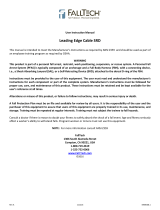
Address: 225 Wilshire Ave SW, Concord, NC 28025 Phone: 800-230-0319 Email: [email protected] Website: safewaze.com Fax: 704-262-9051
I I
ALLOWED ANCHOR APPLICATIONS
LIMITATIONS
Always select a lanyard and anchor point location that limits free fall and swing fall as much as
possible. A free fall of more than 6 ft. could cause excessive arre forces that could result in
serious injury or death.
Structures for the attachment of the Concrete Anchor Strap shall support a minimum 5,000 lbs. (22
kN) or be designed with a safety factor of two to one by a Qualied Person.
Fall Clearance: There must be sucient clearance below the anchorage connector to arrest a fall
before the user strikes the ground or an obstruction. When calculating fall clearance, account for all
applicable factors (Figure 1). A Competent Person must reference the entire system’s components
to calculate Fall Clearance.
FIGURE 1: FALL CLEARANCE DIAGRAM
*These diagrams are examples of fall clearance calculations ONLY.
Swing Falls: Prior to installation or use, make considerations for eliminating or minimizing all
swing fall hazards. Swing falls occur when the anchor is not directly above the location where
a fall occurs. Always work as close to, or in line with, the anchor point as possible. Swing falls
signicantly increase the likelihood of serious injury or death in the event of a fall (Figure 2)
FIGURE 2: SWING FALL
WORKER CLASSIFICATIONS
Read and understand the denitions of those who work in proximity of, or may be exposed
to, fall hazards:
Qualied Engineer: “Qualied Engineer” means a person with a Bachelor of Science in
Engineering degree from an accredited college or university. They are able to assume personal
responsibility for the development and application of engineering science and knowledge in the
design, construction, use, and maintenance of their projects.
Qualied Person: “Qualied Person” means one who, by possession of a recognized degree,
certicate, or professional standing, or who by extensive knowledge, training, and experience, has
successfully demonstrated their ability to solve or resolve problems relating to the subject matter,
the work, or the project.
Competent Person: “Competent Person” means one who is capable of identifying existing and
predictable hazards in the surroundings or working conditions which are unsanitary, hazardous,
or dangerous to employees, and who has authorization to take prompt corrective measures to
eliminate them.
Authorized Person: “Authorized Person” means a person approved or assigned by the employer
to perform a specic type of duty or duties, or to be at a specic location or locations, at the jobsite.
It is the responsibility of a Qualied Person or Engineer to supervise the jobsite and ensure
safety regulations are complied with.
COMPATIBILITY OF COMPONENTS/CONNECTORS
• Safewaze equipment is designed for, and tested with, associated Safewaze components or
systems. If substitutions or replacements are made, ensure all components meet the applicable
ANSI requirements. Read and follow manufacturer’s instructions for all components and
subsystems in your PFAS. Not following this guidance may jeopardize compatibility of equipment
and possibly aect the safety and reliability of the system.
• Connectors are compatible with connecting elements when they have been designed to work
together in such a way that their sizes and shapes do not cause their gate mechanisms to
inadvertently open regardless of how they become oriented.
• Connectors (hooks, carabiners, and D-rings) must be capable of supporting at least 5,000 lbs.
(22 kN).
• Connectors must be compatible with the anchorage or other system components.
• Do not use equipment that is not compatible. Non-compatible connectors may unintentionally
disengage (Figure 3).
• Connectors must be compatible in size, shape, and strength.
• Self-locking snap hooks and carabiners are required by OSHA guidelines.
• Some specialty connectors have additional requirements. Contact Safewaze if you have any
questions about compatibility.
FIGURE 3: UNINTENTIONAL DISENGAGEMENT
Using a connector that is undersized or irregular in shape (1) to connect a snap hook or carabiner
could allow the connector to force open the gate of the snap hook or carabiner. When force is
applied, the gate of the hook or carabiner presses against the non-compliant part (2) and forces
open the gate (3). This allows the snap hook or carabiner to disengage (4) from the connection
point.
2. Gate Presses
Against
Non-Compliant Part
1. Non-Compliant Part 3. Gate Opens
4. Parts
Disengage
ANCHORAGE INSTALLATION LOCATION
A Qualied Person or Engineer must conduct an analysis of the workplace and ensure the
anchorage location is capable of withstanding loads from a fall. An anchorage location selected
for a Personal Fall Arrest System (PFAS) must have a strength capable of sustaining a static load
applied in the direction permitted by the PFAS of at least:
• 5,000 lbs. (2267.9 kg) for non-certied anchorages, or
• Two times the maximum arresting force for certied anchorages, or
• 3,100 lbs. for Rescue applications.
When more than one fall arrest system is attached to an anchorage, the strengths set forth in one
of the above shall be multiplied by the number of systems attached to the anchorage.
MAKING CONNECTIONS
Snap hooks and carabiners used with this equipment must be double locking and/or twist lock.
Ensure all connections are compatible in size, shape, and strength. Do not use equipment that is
not compatible. Ensure all connectors are fully closed and locked.
Safewaze connectors (hooks, carabiners, and D-rings) are designed to be used only as specied
in each product’s manual. See Figure 4 for examples of inappropriate connections. Do not connect
snap hooks and carabiners:
• To a D-ring to which another connector is attached.
• In a manner that would result in a load on the gate (with the exception of tie-back hooks).
• In a false engagement, where features that protrude from the snap hook or carabiner catch on
the anchor, and without visual conrmation seems to be fully engaged to the anchor point.
• To each other.
• By wrapping the web lifeline around an anchor and securing to lifeline, except as allowed for
tie-back models.
• To any object which is shaped or sized in a way that the snap hook or carabiner will not close
and lock, or that roll-out could occur.
• In a manner that does not allow the connector to align properly while under load.
FIGURE 4: INAPPROPRIATE CONNECTIONS
Large throat snap hooks must not be connected to standard size D-rings or similar objects which
will result in a load on the gate if the hook or D-ring twists or rotates, unless the snap hook
complies with ANSI Z359.12 and is equipped with a 3,600 lb. (16 kN) gate.
V2. 2023 Copyright Safewaze: 220-00018
Concrete Anchor Strap Manual
INTRODUCTION
Thank you for purchasing a Safewaze Concrete Anchor Strap. This manual must be read and
understood in its entirety and used as part of an employee training program as required by OSHA
or any applicable state agency. This manual and any other instructional material must be available
to the user of the equipment. Every user must be trained in the inspection, installation, operation,
and proper usage of the anchor.
WARNING:
The manufacturer’s instructions must be provided to users of this equipment. The user must
follow the manufacturer’s instructions for each component of the system. The user must read and
understand these instructions before using this equipment. Manufacturer’s instructions must be
followed for proper use and maintenance of this equipment. The user must understand how to
safely and eectively use the Concrete Anchor Strap and all equipment used in conjunction with
the Concrete Anchor Strap. Alterations to this product, misuse of this product, or failure to follow
instructions may result in serious injury or death. Avoid moving machinery, sharp and/or abrasive
edges, and any other hazard that could damage or degrade the component.
Do not throw away instructions!
Read and understand instructions before using equipment!
IMPORTANT:
• Please refer to this manual for essential instruction on the use, care, or suitability of this
equipment for your application. Contact Safewaze for any additional questions.
• Only Safewaze, or entities authorized in writing by Safewaze, may make repairs to
Safewaze fall protection equipment.
• Record all important product information below prior to use. Documentation of all
Competent Person annual inspections is required in the Inspection Log.
APPLICABLE SAFETY STANDARDS
When used according to instructions, Safewaze Anchors meet ANSI Z359.18-2017 Type A and
OSHA 1926.502, 1910.140, and 1910.66 regulations. Applicable standards and regulations depend
on the type of work being done and may include state-specic regulations. Refer to local, state, and
federal requirements for additional information on the governing of occupational safety regarding
Personal Fall Arrest Systems (PFAS).
SPECIFICATIONS
The Safewaze Concrete Anchor Strap is designed to be used as part of a Personal Fall Arrest
System (PFAS).
• Capacity: ANSI 130 to 310 lbs. (59-141 kg), OSHA 420 lbs. (191 kg) *including any tools,
clothing, accessories, etc.
• Minimum Breaking Strength (MBS): 5,000 lbs. (22 kN)
• Heavy duty webbing with 24’’ wear sleeve and D-ring, or soft loop, connection point.
• Fall Arrest Points: D-ring, Soft Eye Loop.
USER INFORMATION
Date of First Use:
Serial Number:
Trainer:
User:
Restraint: Safewaze Anchors are authorized for use in Restraint applications. The
structure to which the anchor is attached must withstand loads applied in the directions
permitted by the system of at least 1,000 lbs. NO free fall is permitted. Restraint
systems may only be used on surfaces with slopes up to 4/12 (vertical/horizontal). For
Restraint applications, the allowable attachment points to the harness are Dorsal,
Front/Sternal, Side, and Shoulder D-rings.
Work Positioning: Safewaze Anchors are authorized for use in Work Positioning
applications. Work Positioning allows a worker to be supported during suspension while
freeing both hands to conduct work operations. The structure to which the Anchor is
attached must withstand loads applied in the directions permitted by the system of at
least 3,000 lbs. Maximum allowable free fall is 2’ ft. For positioning applications, the
allowable attachment points to the harness are the Side D-rings.
Rescue/Conned Space: Safewaze Anchors are authorized for use in Rescue/
Conned Space applications. Rescue systems are utilized to safely recover a worker
from a conned location or after exposure to a fall. Composition of rescue systems
can vary based upon the type of rescue involved. The structure to which the Anchor
is attached must withstand loads applied in the directions permitted by the system
of at least 3,100 lbs. NO free fall is permitted. For rescue applications, the allowable
attachment points to the harness are Dorsal, Front/Sternal, and Shoulder D-rings.
Personal Fall Arrest: Safewaze Anchors are designed as an anchor point to support a
maximum of 1 PFAS when utilized for fall protection applications. The structure to which
the anchor is attached must withstand loads applied in the directions permitted by the
system of at least 5,000 lbs. (22 kN) or be designed with a safety factor of two to one.
Maximum allowable freefall is based on the connector used.
WORKING SURFACE
19.5' REQUIRED CLEARANCE FROM ANCHOR
19.5' REQUIRED CLEARANCE FROM WORKING SURFACE
11' FREE FALL
1.5'
5'
2'
SAFETY FACTOR
HEIGHT OF WORKER
WORKING SURFACE TO DORSAL
D-RING
6'
1.5'
HARNESS STRETCH
18" MAX. PER ANSI Z359.11-2021
LANYARD LENGTH
2'
SAFETY FACTOR
18.5' REQUIRED CLEARANCE FROM ANCHOR
5'
12' FF LANYARD
BELOW D-RING EXAMPLE
HEIGHT OF WORKER
WORKING SURFACE TO DORSAL
D-RING
5'
DECELERATION DISTANCE
60" MAX. PER
ANSI Z359.13-2013
12.5'
REQUIRED CLEARANCE FROM
WORKING SURFACE
5' FREE FALL
6'
HEIGHT OF ANCHOR
0' HEIGHT OF ANCHOR
HARNESS STRETCH
18" MAX. PER ANSI Z359.11-2021
6' FF LANYARD
OVERHEAD EXAMPLE
4'
DECELERATION DISTANCE
48" MAX. PER
ANSI Z359.13-2013
6'
LANYARD LENGTH
16.5' REQUIRED CLEARANCE FROM ANCHOR
5' FREE FALL 16.5'
REQUIRED CLEARANCE FROM WORKING SURFACE
7'
REQUIRED CLEARANCE
FROM WORKING SURFACE
2'
SWING FALL DROP DISTANCE
SAFETY FACTOR
1.5'
HEIGHT OF WORKER
WORKING SURFACE TO DORSAL
D-RING
5'
ARREST DISTANCE
42" MAX. PER
ANSI Z359.14-2021 CLASS 1
3.5'
TBD
WORKING SURFACE
CLASS 1 OVERHEAD
EXAMPLE
CLASS 2 BELOW D-RING
EXAMPLE
6'
HEIGHT OF ANCHOR
SWING FALL DROP DISTANCE
HARNESS STRETCH
18" MAX. PER ANSI Z359.11-2021
1.5'
HARNESS STRETCH
18" MAX. PER ANSI Z359.11-2021
TBD
13' REQUIRED CLEARANCE FROM ANCHOR
0' FREE FALL
WORKING SURFACE
0'
HEIGHT OF ANCHOR
ARREST DISTANCE
REFER TO MANUAL FOR P UBLISHED
ARREST DISTANCES PER ANSI
Z359.14-2021 CLASS 2
8'
SAFETY FACTOR
2'
Always verify the latest revision of the Safewaze Manual is being utilized. Visit the Safewaze
website, or contact Customer Service, for updated manuals.

Address: 225 Wilshire Ave SW, Concord, NC 28025 Phone: 800-230-0319 Email: [email protected] Website: safewaze.com Fax: 704-262-9051 II
INSTALLATION
1. To install a Safewaze Concrete Anchor Strap, select a suitable location that
will provide proper strength for installation of the strap as an anchorage for Fall
Protection.
2. Upon determining a suitable location for installation of a Safewaze Concrete
Anchor Strap, the user will will secure the strap to a suitable rebar cage
component prior to concrete being poured. Attachment to the rebar component
is performed by simply passing the PFAS attachment end of the strap throught the
loop at the opposite end of the strap and cinching the strap around the rebar.
3. The PFAS end of the Safewaze Concrete Anchor Strap will then be extended
beyond the edge/side of the form to allow for connection after concrete is poured
and has properly cured.
4. After concrete has properly cured, the user can then attach to the end of
the strap that extends beyond the concrete to provide a suitable fall protection
anchorage point.
5. Once construction is complete, or the strap is no longer required, the user can
choose to leave the strap in place for possible future usage, or cut the strap off
flush with the edge of the concrete and discard.
Installing on Completed Cage
Pass web loop end through web loop end and
pull to tighten on rebar structure Note: Though installation in concrete is the intended use, Safewaze Concrete
Anchor Straps can also be used as temporary anchors on alternative structural
members, such as wood framework, steel I-beams, or pipe racking.
For instance, the Concrete Anchor Strap could be installed like a Cross Arm
Strap on the aforementioned alternative structural members. However, use of this
product in a manner in which it is not designed can lead to excessive abrasion,
wear, and possible product failure.
For this reason, this product must be inspected before each use. The use of a
Concrete Anchor Strap on an alternative structural member is permissible provided
the user follows this Safewaze product manual and the following guidelines:
1. A Competent Person has determined the alternative structural member is
capable of withstanding anticipated fall loads and meets, or exceeds, OSHA
required anchorage strength regulations.
2. The chosen alternative structural member does not allow for the Concrete
Anchor Strap to slip o of it, or become unintentionally disengaged in any capacity.
3. The chosen alternative structural member does not have any sharp or abrasive
edges or surfaces.
FIGURE 5: ANCHOR COMPONENTS
INSPECTION LOG
WARNINGS
• Users should consult with their doctor to verify ability to safely absorb the forces of a fall arrest
event. Fitness level, age, and other health conditions can greatly affect an individuals ability to
withstand fall arrest forces. Women who are pregnant and individuals considered minors must
not use any Safewaze equipment.
• Anchors that are exposed to fall arrest forces must be IMMEDIATELY removed from service
and destroyed.
• A preplanned rescue procedure in the event of a fall is required. The rescue plan must be
specific to the project. The rescue plan must allow for employees to rescue themselves or be
promptly rescued by alternative means.
• A Competent Person must conduct an analysis of the workplace and anticipate where workers
will be conducting their duties, the route they will take to reach their work, and the existing and
potential fall hazards they may be exposed to. The Competent Person must choose the fall
protection equipment to be utilized.
• Equipment designated for fall protection must never be used to lift, hang, support, or hoist tools
or equipment unless specifically certified for such use.
MAINTENANCE
• The anchor can be cleaned with water and mild soap if necessary. The user should remove all
dirt, possible corrosives, and contaminants from the anchor prior to, and after, each use. Never
use any type of corrosive substance to clean the anchor.
• Excess water should be blown out with compressed air. Hardware can be wiped off with a
clean, dry cloth. Do not store anchor if wet or damp. Allow anchor to fully dry before being
stored.
• Prior to installation, store the anchor in a cool, dry area where it will not be exposed to extreme
light, extreme heat, excessive moisture, or possibly corrosive chemicals or materials.
LABELS
INSPECTION
• Safewaze Anchors shall be inspected prior to each use by the user and at least annually by a
Competent Person other than the user.
• Competent Person inspections must be recorded in the Inspection Log included in this manual
and on the inspection grid label on the anchor.
• Severity of conditions during use of the anchor may necessitate increased frequency of
documented inspections.
• Prior to each use, inspect the anchor for deficiencies or damage including, but not limited to,
sharp edges, rough edges, deformations, corrosion, pits, burrs, chemical exposure, extreme
heat exposure, and damaged, missing, or illegible labels.
• If any deficiencies or defects are found, the anchor must IMMEDIATELY be removed from
service.
2
1Loop End
2PFAS Connection Point
3Wear Sleeve
2
1 1
3 3
Installing on Completed Cage
Pass D-ring end through web loop and
pull to tighten on rebar structure
Concrete Column
Steel Reinforcing Rebar
Concrete Anchor Strap
Concrete Floor
Concrete Wall
Concrete Column
Steel Reinforcing Rebar
Concrete Anchor Strap
Concrete Floor
Concrete Wall
FS880
01130
MODEL #: FS880 I 4 FT CONCRETE ANCHOR STRAP
SERIAL #: XXXXXXXX MFG DATE: XX/XXXX
-MATERIALS: Polyester webbing; steel hardware
-MAX WEIGHT CAPACITY: 310 lbs.
-AVOID CONTACT WITH SHARP EDGES AND SURFACES
-ONLY MAKE COMPATIBLE CONNECTIONS
-INSPECT BEFORE EACH USE
-ANY UNIT WHICH HAS BEEN EXPOSED TO FALL ARREST FORCES MUST BE REMOVED FROM SERVICE
-DO NOT REMOVE LABEL
-MINIMUM BREAKING STRENGTH: 5000 lbf / 22.25kN
MUST FOLLOW ALL MFG’S INSTRUCTIONS INCLUDED WITH THE EQUIPMENT AT TIME OF SHIPMENT
Meets: OSHA 1926.502, 1910.140, 1910.66; ANSI Z359.18-2017 (TYPE A)
225 Wilshire Ave SW
Concord, NC 28025
USA
(800) 230-0319
www.safewaze.com
70200
MODEL #: 70200
DESCRIPTION: 6 FT CONCRETE ANCHOR STRAP
SERIAL #: XXXXXXXX MFG DATE: XX/XXXX
-MATERIALS: Polyester webbing
-MAX WEIGHT CAPACITY: 310 lbs.
-AVOID CONTACT WITH SHARP EDGES AND SURFACES
-ONLY MAKE COMPATIBLE CONNECTIONS
-INSPECT BEFORE EACH USE
-ANY UNIT WHICH HAS BEEN EXPOSED TO FALL ARREST
FORCES MUST BE REMOVED FROM SERVICE
-DO NOT REMOVE LABEL
-MINIMUM BREAKING STRENGTH: 5000 lbf / 22.25kN
MUST FOLLOW ALL MFG’S INSTRUCTIONS INCLUDED WITH
THE EQUIPMENT AT TIME OF SHIPMENT
Meets: ANSI Z359.18-2017 (TYPE A);
OSHA 1926.502, 1910.140, 1910.66
225 Wilshire Ave SW
Concord, NC 28025
USA
P: (800) 230-0319
www.safewaze.com
XXXXXXX
S/N
MADE IN CHINA
WARNING: Manufacturer's instructions supplied with the equipment at the time of shipment must
be followed. Only make compatible connections. Inspect before each use. Do not use if wear or
damage is present. Any unit which has been exposed to fall arrest forces must be removed from
service. Avoid contact with sharp edges and surfaces. This item is not flame or heat resistant
unless otherwise specified. DO NOT REMOVE THIS LABEL.
INSPECTION LOG
Inspection
Date:
Inspector: Pass/Fail: Comments/
Corrective Action:
INSPECTION LOG
ANNUAL FORM

Address: 225 Wilshire Ave SW, Concord, NC 28025 Phone: 800-230-0319 Email: [email protected] Website: safewaze.com Fax: 704-262-9051
I I
APLICACIONES DE ANCLAJE PERMITIDAS
LIMITACIONES
Siempre seleccione una cuerda de seguridad y una ubicación del punto de anclaje que limite la caída libre
y el balanceo tanto como sea posible. Una caída libre de más de 6 pies podría causar fuerzas de detención
excesivas que podrían resultar en lesiones graves o la muerte.
Las estructuras para la jación de la Correa de Anclaje de Concreto deben soportar un mínimo de 5,000 lbs
(22 kN) o estar diseñadas con un factor de seguridad de dos a uno por una Persona Calicada.
Espacio libre en caso de caída: Debe haber un espacio suciente debajo del conector de anclaje para
detener una caída antes de que el usuario toque el suelo u otro obstáculo. Al calcular el espacio libre en caso
de caída, tenga en cuenta todos los factores aplicables (Figura 1). Una Persona Competente debe hacer
referencia a los componentes del sistema completo para calcular el espacio libre en caso de caída.
FIGURA 1: DIAGRAMA DEL ESPACIO LIBRE EN CASO DE CAÍDA
*Estos diagramas son ejemplos únicamente de cálculos de espacio libre en caso de caída.
Caídas con Balanceo: Antes de la instalación o el uso, considere eliminar o minimizar todos
los riesgos de caídas con balanceo. Las caídas con balanceo ocurren cuando el anclaje no está
directamente sobre el lugar donde ocurre la caída. Siempre trabaje lo más cerca posible o en línea
con el punto de anclaje. Las caídas con balanceo aumentan signicativamente la probabilidad de
lesiones graves o la muerte en caso de una caída (Figura 2).
FIGURA 2: Caídas con Balanceo
CLASIFICACIONES DE TRABAJADORES
Lea y comprenda las deniciones de quiences trabajan en proximidad o pueden estar
expuestos a riesgos de caida:
Ingeniero Calicado: “Ingeniero Calicado” se reere a una persona con un título de Licenciado en
Ciencias de la Ingeniería de una universidad acreditada. Tienen la capacidad de asumir la responsabilidad
personal en el desarrollo y aplicación de la ciencia y el conocimiento de ingeniería en el diseño,
construcción, uso y mantenimiento de sus proyectos.
Persona Calicada: “Persona Calicada” se reere a alguien que, por la posesión de un título reconocido,
un certicado o una posición profesional, o que mediante conocimientos extensos, capacitación y
experiencia, ha demostrado con éxito su capacidad para resolver problemas relacionados con la materia,
el trabajo o el proyecto.
Persona Competente: “Persona Competente” se reere a alguien capaz de identicar peligros existentes
y previsibles en el entorno o condiciones de trabajo que sean insalubres, peligrosas o riesgosas para los
empleados, y que tiene autorización para tomar medidas correctivas oportunas para eliminarlos.
Persona Autorizada: “Persona Autorizada” se reere a una persona aprobada o asignada por el
empleador para desempeñar un tipo especíco de tarea o tareas, o para estar en una ubicación o
ubicaciones especícas en el lugar de trabajo.
Es responsabilidad de una Persona Calicada o Ingeniero supervisar el lugar de trabajo y garantizar
el cumplimiento de las regulaciones de seguridad.
COMPATIBILIDAD DE COMPONENTES/CONECTORES
• El equipo Safewaze está diseñado y probado con componentes o sistemas asociados de Safewaze. Si se
realizan sustituciones o reemplazos, asegúrese de que todos los componentes cumplan con los requisitos
ANSI aplicables. Lea y siga las instrucciones del fabricante para todos los componentes y subsistemas en
su PFAS. No seguir esta orientación puede poner en peligro la compatibilidad del equipo y posiblemente
afectar la seguridad y conabilidad del sistema.
• Los conectores son compatibles con los elementos de conexión cuando han sido diseñados para funcionar
juntos de tal manera que sus tamaños y formas no causen que sus mecanismos de compuerta se abran
inadvertidamente, independientemente de cómo estén orientados.
• Los conectores (ganchos, mosquetones y anillos en D) deben ser capaces de soportar al menos 5,000
lbs. (22 kN)
• Los conectores deben ser compatibles con el punto de anclaje y otros componentes del sistema.
• No utilice equipos que no sean compatibles. Los conectores no compatibles pueden desengancharse
involuntariamente (Figura 3).
• Los conectores deben ser compatibles en tamaño, forma y resistencia.
• Los ganchos automáticos de cierre y los mosquetones de cierre automático son requeridos según las
pautas de OSHA.
• Algunos conectores especializados tienen requisitos adicionales. Póngase en contacto con Safewaze si
tiene alguna pregunta sobre la compatibilidad.
FIGURA 3: DESCONEXIÓN NO INTENCIONAL
Utilizar un conector que sea de menor tamaño o tenga una forma irregular (1) para conectar un mosquetón
o un gancho podría permitir que el conector fuerce la apertura de la compuerta del mosquetón o del gancho.
Cuando se aplica fuerza, la compuerta del gancho o del mosquetón presiona contra la parte no conforme (2)
y fuerza la apertura de la compuerta (3). Esto permite que el mosquetón o el gancho se desconecten (4) del
punto de conexión.
2. La compuerta
contra pieza
incompatible
1. Pieza incompatible 3. La compuerta se abre
4. La piezas se
desenganchan
UBICACIÓN DE INSTALACIÓN DEL ANCLAJE
Una Persona Calicada o Ingeniero debe realizar un análisis del lugar de trabajo y asegurarse de que la
ubicación del anclaje sea capaz de soportar las cargas de una caída. Una ubicación de anclaje seleccionada
para un Sistema Personal de Detención de Caídas (Personal Fall Arrest System - PFAS) debe tener una
resistencia capaz de soportar una carga estática aplicada en la dirección permitida por el PFAS de al menos:
• 5,000 libras (2267.9 kg) para anclajes no certicados, o
• El doble de la fuerza máxima de detención para anclajes certicados, o
• 3,100 libras para aplicaciones de rescate.
Cuando más de un sistema de detención de caídas esté conectado a un anclaje, las resistencias establecidas
en uno de los casos anteriores deben multiplicarse por el número de sistemas conectados al anclaje.
REALIZANDO CONEXIONES
Los ganchos rápidos y los mosquetones utilizados con este equipo deben ser de doble bloqueo y/o bloqueo
por giro. Asegúrese de que todas las conexiones sean compatibles en tamaño, forma y resistencia. No utilice
equipos que no sean compatibles. Asegúrese de que todos los conectores estén completamente cerrados
y bloqueados.
Los Safewaze conectores (ganchos, mosquetones y anillos D) están diseñados para ser utilizados
únicamente según lo especicado en el manual de cada producto. Consulte la Figura 4 para ejemplos de
conexiones inapropiadas. No conecte ganchos rápidos y mosquetones:
• A una anillo D a la que está conectado otro conector.
• De una manera que resultaría en una carga en la puerta (con excepción de los ganchos de amarre).
• En un enganche falso, donde características que sobresalen del gancho rápido o mosquetón se
enganchen en el punto de anclaje y sin conrmación visual parezca estar completamente enganchado
al punto de anclaje.
• Uno al otro.
• Enrollando la línea de vida de tela alrededor de un punto de anclaje y asegurándola a la línea de vida,
excepto según lo permitido para modelos de amarre.
• A cualquier objeto que tenga una forma o tamaño que impida que el gancho rápido o mosquetón se
cierre y bloquee, o que pueda desenrollarse.
• De una manera que no permita que el conector se alinee correctamente bajo carga.
FIGURA 4: INAPPROPRIATE CONNECTIONS
Los ganchos de garganta grande no deben conectarse a anillos D de tamaño estándar u objetos similares
que resultarán en una carga en la puerta si el gancho o la anillo D gira o rota, a menos que el gancho de
amarre cumpla con la norma ANSI Z359.12 y esté equipado con una puerta de 3,600 lb. (16 kN).
V2. 2023 Copyright Safewaze: 220-00018
Correa de Anclaje para Concreto
Manual
INTRODUCCIÓN
Gracias por comprar una Correa de Anclaje de Concreto de Safewaze. Este manual debe ser
leído y comprendido en su totalidad y utilizado como parte de un programa de capacitación de
empleados, según lo requiere la OSHA o cualquier agencia estatal aplicable. Este manual y
cualquier otro material instructivo deben estar disponibles para el usuario del equipo. Todos los
usuarios deben recibir formación en la inspección, instalación, operación y uso adecuado del
anclaje.
ADVERENCIA
Las instrucciones del fabricante deben ser proporcionadas a los usuarios de este equipo. El usuario debe
seguir las instrucciones del fabricante para cada componente del sistema. El usuario debe leer y comprender
estas instrucciones antes de usar este equipo. Las instrucciones del fabricante deben seguirse para el uso
y mantenimiento adecuados de este equipo. El usuario debe comprender cómo usar de manera segura y
efectiva la Correa Anclaje de Concreto y todo el equipo utilizado junto con la Correa Anclaje de Concreto. Las
alteraciones a este producto, el uso indebido de este producto o la falta de seguimiento de las instrucciones
pueden resultar en lesiones graves o la muerte. Evite mover maquinaria, bordes alados y/o abrasivos y
cualquier otro peligro que pueda dañar o degradar el componente.
¡No tire las instrucciones!
¡Lea y comprenda las instrucciones antes de usar el equipo!
IMPORTANTE:
• Consulte este manual para obtener instrucciones esenciales sobre el uso, cuidado o idoneidad
de este equipo para su aplicación. Póngase en contacto con Safewaze si tiene alguna pregunta
adicional.
• Solo Safewaze o las entidades autorizadas por escrito por Safewaze pueden realizar reparaciones
en el equipo de protección contra caídas de Safewaze.
• Registre toda la información importante del producto a continuación antes de usarlo. Se requiere
documentación de todas las inspecciones anuales realizadas por una Persona Competente en el
Registro de Inspección.
NORMAS DE SEGURIDAD APLICABLES
Cuando se utilizan según las instrucciones, los Anclajes Safewaze cumplen con las normas ANSI Z359.18-
2017 Tipo A y las regulaciones de OSHA 1926.502, 1910.140 y 1910.66. Las normas y regulaciones
aplicables dependen del tipo de trabajo que se esté realizando y pueden incluir regulaciones especícas
del estado. Consulte los requisitos locales, estatales y federales para obtener información adicional sobre la
regulación de la seguridad ocupacional en lo que respecta a los Sistemas Personales de Detención de Caídas
(Personal Fall Arrest Syetems - PFAS).
ESPECIFICACIONES
La Safewaze Concrete Anchor Strap está diseñada para ser utilizada como parte de un Sistema
Personal de Retención en Caso de Caída (PFAS).
INFORMACIÓN DEL USUARIO
Fetcha de primer uso:
Numero de Serie:
Instructor:
Usuario:
Restricción: Los anclajes de Safewaze están autorizados para su uso en aplicaciones de restricción.
La estructura a la cual se adjunta el anclaje debe resistir cargas aplicadas en las direcciones permiti-
das por el sistema de al menos 1,000 lbs. NO se permite caída libre. Los sistemas de restricción solo
pueden utilizarse en supercies con pendientes de hasta 4/12 (vertical/horizontal). Para aplicaciones
de restricción, los puntos de sujeción permitidos en el arnés son los Dorsales, Frontales/Esternales,
Laterales y de Hombros.
Posicionamiento en el Trabajo: Los anclajes de Safewaze están autorizados para su uso en
aplicaciones de Posicionamiento en el Trabajo. El Posicionamiento en el Trabajo permite que un
trabajador sea sostenido durante la suspensión, al tiempo que libera ambas manos para llevar a cabo
las operaciones de trabajo. La estructura a la cual se adjunta el anclaje debe resistir cargas aplicadas
en las direcciones permitidas por el sistema de al menos 3,000 lbs. La caída libre máxima permitida
es de 2 pies. Para aplicaciones de posicionamiento, los puntos de sujeción permitidos en el arnés son
los anillos de D Laterales.
Rescate/Espacios Connados: Los Anclajes Safewaze están autorizados para su uso en
aplicaciones de rescate y espacios connados. Los sistemas de rescate se utilizan para recuperar
de manera segura a un trabajador de una ubicación connada o después de una exposición a una
caída. La estructura a la que se conecta el Anclaje debe resistir cargas aplicadas en las direcciones
permitidas por el sistema de al menos 3,100 lbs. NO se permite la caída libre. Para las aplicaciones
de rescate, los puntos de anclaje permitidos en el arnés son los Dorsales, Frontales/Esternales y los
anillos de D de los Hombros.
Arresto de Caídas Personal: Los anclajes de Safewaze están diseñados como un punto de anclaje
para soportar un máximo de 1 Sistema de Arresto Personal (PFAS) cuando se utilizan en aplicaciones
de protección contra caídas. La estructura a la cual se adjunta el anclaje debe resistir cargas apli-
cadas en las direcciones permitidas por el sistema de al menos 5,000 lbs. (22 kN) o estar diseñada
con un factor de seguridad de dos a uno. La longitud máxima permitida de caída libre depende del
conector utilizado.
ESPACIO DE TRABAJO
19.5' ESPACIO NECESARIO DEESDE EL ANCLAJE
19.5' ESPACIO REQUERIDO DESDE LA SUPERFICIE DE
TRABAJO
11' CAIDA LIBRE
1.5'
5'
2'
FACTOR DE SEGURIDAD
ALTURA DEL TRABAJADOR
SUPERFICIE DE TRABAJO AL
ANILLO D DORSAL
6'
1.5'
ESTIRAMIENTO DEL ARNES
18" MAX. POR ANSI Z359.11-2021
LONGITUD DE LA LINEA DE VIDA
2'
FACTOR DE SEGURIDAD
18.5' ESPACIO NECESARIO DEESDE EL ANCLAJE
5'
EJEMPLO DE LINEA DE VIDA 12' FF POR ENCIMA
ALTURA DEL TRABAJADOR
SUPERFICIE DE TRABAJO AL
ANILLO D DORSAL
5'
DISTANCIA DE DESACELERACION
60" MAX. POR
ANSI Z359.13-2013
12.5' ESPACIO REQUERIDO DESDE
LA SUPERFICIE DE TRABAJO
5' CAIDA
LIBRE
6' ALTURA DEL ANCLAJE
0' ALTURA DE ANCLAJE
ESTIRAMIENTO DEL ARNES
18" MAX. POR ANSI Z359.11-2021
EJEMPLO DE LINEA
DE VIDA 6' FF POR
ENCIMA
4'
DISTANCIA DE DESACELERACION
48" MAX. POR
ANSI Z359.13-2013
6'
LONGITUD DE LA LINEA DE VIDA
16.5' ESPACIO NECESARIO DEESDE EL ANCLAJE
5' CAIDA
LIBRE
16.5' ESPACIO REQUERIDO DESDE LA SUPERFICIE DE
TRABAJO
7' ESPACIO REQUERIDO
DESDE LA SUPERFICIE DE
TRABAJO
2'
DISTANCIA DE CAIDA DE OSCILACION
FACTOR DE SEGURIDAD
1.5'
ALTURA DE TRABAJADOR
SUPERFICIE DE TRABAJO AL
ANILLO D DORSAL
5'
DISTANCIA DE DETENCION
42" MAX. POR
ANSI Z359.14-2021 CLASS 1
3.5'
TBD
ESPACIO DE TRABAJO
EJEMPLO DE CLASE 1
SOBRE LA CABEZA
EJEMPLO DE CLASE 2 POR
DEBAJO DEL ANILLO D
6' ALTURA DE ANCLAJE
DISTANCIA DE CAIDA DE OSCILACION
ESTIRAMIENTO DEL ARNES
18" MAX. PER ANSI Z359.11-2021
1.5'
ESTIRAMIENTO DEL ARNES
18" MAX. POR ANSI Z359.11-2021
TBD
13' ESPACIO NECESARIO DEESDE EL ANCLAJE
0' CAIDA
LIBRE
ESPACIO DE TRABAJO
0' ALTURA DE ANCLAJE
DISTANCIA DE DETENCION
CONSULTE EL MANUAL PARA LAS
DISTANCIAS DE DETENCION
PUBLICADAS POR
Z359.14-2021 CLASS 2
8'
FACTOR DE SEGURIDAD
2'
Siempre verifique que se esté utilizando la última revisión del Manual de Safewaze. Visite el sitio web de
Safewaze o comuníquese con el Servicio al Cliente para obtener manuales actualizados.
• Capacidad: ANSI de 130 a 310 lbs. (59-141 kg), OSHA de 420 lbs. (191 kg), *incluyendo
herramientas, ropa, accesorios, etc.
• Resistencia Mínima a la Rotura: 5,000 lbs. (22 kN)
• Correa resistente con funda de 24’’ y punto de conexión de anillo D o lazo suave.
• Puntos de Retención en Caso de Caída: Anillo D, Lazo de Ojo Suave.

Address: 225 Wilshire Ave SW, Concord, NC 28025 Phone: 800-230-0319Email: [email protected]Website: safewaze.com Fax: 704-262-9051 II
INSTALACIÓN
1. Para instalar una Safewaze Correa Anclaje de Concreto, seleccione una
ubicación adecuada que proporcione la resistencia necesaria para la instalación
de la correa como punto de anclaje para la protección contra caídas.
2. Cuando determinado un ubicación adecuada para la instalación de una Correa
Anclaje de Concreto, el usuario asegurará la correa a un componente adecuado
de la estructura de refuerzo antes de que se vierta el concreto. La fijación al
componente de refuerzo se realiza simplemente pasando el extremo de la correa
destinado a la conexión del PFAS a través del lazo en el extremo opuesto de la
correa y ajustando la correa alrededor del refuerzo.
3. El extremo del PFAS de la Safewaze Correa Anclaje de Concreto se extenderá
más allá del borde/lado del encofrado para permitir la conexión después de que se
haya vertido el concreto y haya curado adecuadamente.
4. Después de que el concreto haya curado adecuadamente, el usuario podrá
entonces conectar el extremo de la correa que se extiende más allá del concreto
para proporcionar un punto de anclaje adecuado para la protección contra caídas.
5. Una vez que la construcción esté completa, o la correa ya no sea necesaria, el
usuario puede optar por dejar la correa en su lugar para un posible uso futuro, o
cortar la correa al ras con el borde del concreto y desecharla.
Instalación en jaula terminada
Pase el extremo del bucle de la correa a través del
extremo del bucle de la correa y tire para apretar en la
estructura de refuerzo (o rebar).structure Nota: Aunque la instalación en concreto es el uso previsto, las Correas de Anclaje para
Concreto Safewaze también se pueden utilizar como anclajes temporales en otros
elementos estructurales alternativos, como marcos de madera, vigas de acero o racks
de tuberías.
Por ejemplo, la Correa de Anclaje para Concreto se podría instalar como una Correa de
Brazo Cruzado en los elementos estructurales alternativos mencionados. Sin embargo, el
uso de este producto de una manera para la cual no está diseñado puede dar lugar a una
abrasión excesiva, desgaste y posibles fallos del producto.
Por esta razón, este producto debe ser inspeccionado antes de cada uso. El uso de una
Correa de Anclaje para Concreto en un elemento estructural alternativo es permitido
siempre que el usuario siga este manual de producto de Safewaze y las siguientes
pautas:
1. Un Competente ha determinado que el elemento estructural alternativo es capaz
de soportar las cargas de caída anticipadas y cumple o supera las regulaciones de
resistencia de anclaje requeridas por OSHA.
2. El elemento estructural alternativo elegido no permite que la Correa de Anclaje para
Concreto se deslice de él ni se desenganche involuntariamente de ninguna manera.
3. El elemento estructural alternativo elegido no tiene bordes o supercies alados o
abrasivos.
FIGURA 5: COMPONENTES DEL ANCLAJE
REGISTRO DE INSPECCIÓN
ADVERTENCIAS
• Los usuarios deben consultar con su médico para verificar su capacidad de absorber de manera segura
las fuerzas de una detención de caída. El nivel de condición física, la edad y otras condiciones de salud
pueden afectar significativamente la capacidad de una persona para resistir las fuerzas de detención de
caída. Las mujeres embarazadas y las personas consideradas menores de edad no deben utilizar ningún
equipo de Safewaze.
• Los anclajes expuestos a fuerzas de detención de caída deben ser RETIRADOS INMEDIATAMENTE
del servicio y destruidos. Se requiere un procedimiento de rescate planificado en caso de una caída. El
plan de rescate debe ser específico para el proyecto y debe permitir que los empleados se rescaten a sí
mismos o sean rescatados de manera pronta por otros medios.
• Un Persona Competente debe llevar a cabo un análisis del lugar de trabajo y anticipar dónde los
trabajadores llevarán a cabo sus labores, la ruta que tomarán para llegar a su trabajo y los peligros de
caída existentes y potenciales a los que podrían estar expuestos. La Persona Competente debe elegir el
equipo de protección contra caídas a utilizar.
• El equipo designado para la protección contra caídas nunca debe utilizarse para levantar, colgar, sostener
o elevar herramientas o equipos, a menos que esté certificado específicamente para dicho uso.
MANTENIMIENTO
• El anclaje se puede limpiar con agua y jabón suave si es necesario. El usuario debe eliminar toda la
suciedad, posibles agentes corrosivos y contaminantes del anclaje antes y después de cada uso. Nunca
utilice ningún tipo de sustancia corrosiva para limpiar el anclaje.
• El exceso de agua debe ser expulsado con aire comprimido. El hardware se puede limpiar con un paño
limpio y seco. No almacene el anclaje si está mojado o húmedo. Permita que el anclaje se seque comple-
tamente antes de guardarlo.
• Antes de la instalación, almacene el anclaje en un área fresca y seca donde no esté expuesto a una luz
extrema, calor excesivo, humedad excesiva o sustancias químicas o materiales corrosivos.
ETIQUESTAS
INSPECCIÓN
• Los anclajes Safewaze deben ser inspeccionados antes de cada uso por el usuario y al menos
anualmente por una Persona Competente distinta al usuario.
• Las inspecciones de la Persona Competente deben registrarse en el Registro de Inspección incluido en
este manual y en la etiqueta de la rejilla de inspección del anclaje.
• La gravedad de las condiciones durante el uso del anclaje puede requerir una mayor frecuencia de
inspecciones documentadas.
• Antes de cada uso, inspeccione el anclaje en busca de deficiencias o daños, incluyendo, pero no
limitado a, bordes afilados, bordes rugosos, deformaciones, corrosión, picaduras, rebabas, exposición a
productos químicos, exposición a calor extremo y etiquetas dañadas, faltantes o ilegibles.
• Si se encuentran deficiencias o defectos, el anclaje DEBE SER retirado INMEDIATAMENTE del servicio.
2
1Extremo en bucle
2Punto de conexion
del PFAS
3Manga protectora
2
1 1
3 3
Instalación en jaula terminada
Pase el extremo del anillo en D a través del
lazo de la cinta y tire para ajustar en la
estructura de refuerzo.
COLUMNA DE CONCRETO
BARRAS DE REFUERZO DE ACERO
CORREA DE ANCLAJE
PISO DE CONCRETO
PARED DE CONCRETO
COLUMNA DE CONCRETO
BARRAS DE REFUERZO DE ACERO
CORREA DE ANCLAJE
PISO DE CONCRETO
PARED DE CONCRETO
FS880
01130
MODEL #: FS880 I 4 FT CONCRETE ANCHOR STRAP
SERIAL #: XXXXXXXX MFG DATE: XX/XXXX
-MATERIALES: Cinta de poliéster; herrajes de acero
-CAPACIDAD MÁXIMA DE PESO: 310 libras.
-EVITE EL CONTACTO CON BORDES Y SUPERFICIES AFILADAS
-REALICE ÚNICAMENTE CONEXIONES COMPATIBLES
-INSPECCIONE ANTES DE CADA USO
-CUALQUIER UNIDAD EXPUESTA A FUERZAS DE ARRESTO DE CAÍDA DEBE SER RETIRADA DEL
SERVICIO
-NO RETIRE LA ETIQUETA
-Resistencia Minima a la Rotura: 5000 lbf / 22.25kN
DEBE SEGUIR TODAS LAS INSTRUCCIONES DEL FABRICANTE INCLUIDAS CON EL EQUIPO EN EL
MOMENTO DEL ENVÍO
- Meets: OSHA 1926.502, 1910.140, 1910.66; ANSI Z359.18-2017 (TYPE A)
225 Wilshire Ave SW
Concord, NC 28025
USA
(800) 230-0319
www.safewaze.com
70200
MODEL #: 70200
DESCRIPTION: 6 FT CONCRETE ANCHOR STRAP
SERIAL #: XXXXXXXX MFG DATE: XX/XXXX
-MATERIALES: Cinta de poliéster; herrajes de acero
-CAPACIDAD MÁXIMA DE PESO: 310 libras.
-EVITE EL CONTACTO CON BORDES Y SUPERFICIES
AFILADAS
-REALICE ÚNICAMENTE CONEXIONES COMPATIBLES
-INSPECCIONE ANTES DE CADA USO
-CUALQUIER UNIDAD EXPUESTA A FUERZAS DE ARRESTO
DE CAÍDA DEBE SER RETIRADA DEL SERVICIO
-NO RETIRE LA ETIQUETA
-Resistencia Minima a la Rotura: 5000 lbf / 22.25kN
DEBE SEGUIR TODAS LAS INSTRUCCIONES DEL
FABRICANTE INCLUIDAS CON EL EQUIPO EN EL
MOMENTO DEL ENVÍO
-
Cumple: ANSI Z359.18-2017 (TYPE A);
OSHA 1926.502, 1910.140, 1910.66
225 Wilshire Ave SW
Concord, NC 28025
USA
P: (800) 230-0319
www.safewaze.com
XXXXXXX
S/N
MADE IN CHINA
ADVERTENCIA: Deben seguirse las instrucciones del fabricante suministradas con el equipo en el momento del
envío. Solo haga conexiones compatibles. Inspeccione antes de cada uso. No lo use si muestra desgaste o daño.
Cualquier unidad que haya estado expuesta a fuerzas de detención de caídas debe retirarse del servicio. Evite el
contacto con bordes y superficies afiladas. Este artículo no es resistente al fuego o al calor a menos que se especifique
lo contrario. NO RETIRE ESTA ETIQUETA.
REGISTRO DE INSPECCION
FECHA DE
INSPECCION:Inspector:
APROBADO/
REPROBADO:COMENTARIOS/
ACCION CORRECTIVA
REGISTRO DE INSPECCION
Formulario Anual
-
 1
1
-
 2
2
-
 3
3
-
 4
4
en otros idiomas
- English: SafeWaze 70300 Owner's manual
Artículos relacionados
-
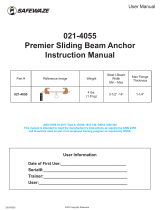 SafeWaze 021-4055 El manual del propietario
SafeWaze 021-4055 El manual del propietario
-
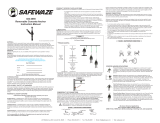 SafeWaze 022-4085 El manual del propietario
SafeWaze 022-4085 El manual del propietario
-
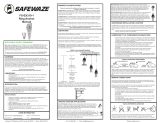 SafeWaze FS-EX310-1 El manual del propietario
SafeWaze FS-EX310-1 El manual del propietario
-
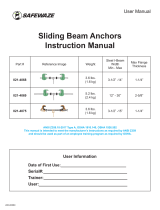 SafeWaze 021-4068 El manual del propietario
SafeWaze 021-4068 El manual del propietario
-
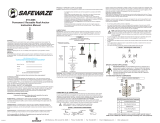 SafeWaze 019-4006 El manual del propietario
SafeWaze 019-4006 El manual del propietario
-
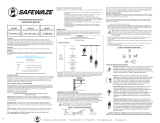 SafeWaze 020-4025 El manual del propietario
SafeWaze 020-4025 El manual del propietario
-
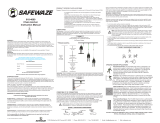 SafeWaze 018-4000 El manual del propietario
SafeWaze 018-4000 El manual del propietario
-
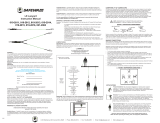 SafeWaze 019-2015 El manual del propietario
SafeWaze 019-2015 El manual del propietario
-
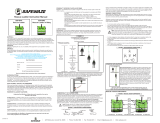 SafeWaze 020-6042 El manual del propietario
SafeWaze 020-6042 El manual del propietario
-
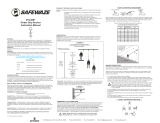 SafeWaze 019-4007 El manual del propietario
SafeWaze 019-4007 El manual del propietario














